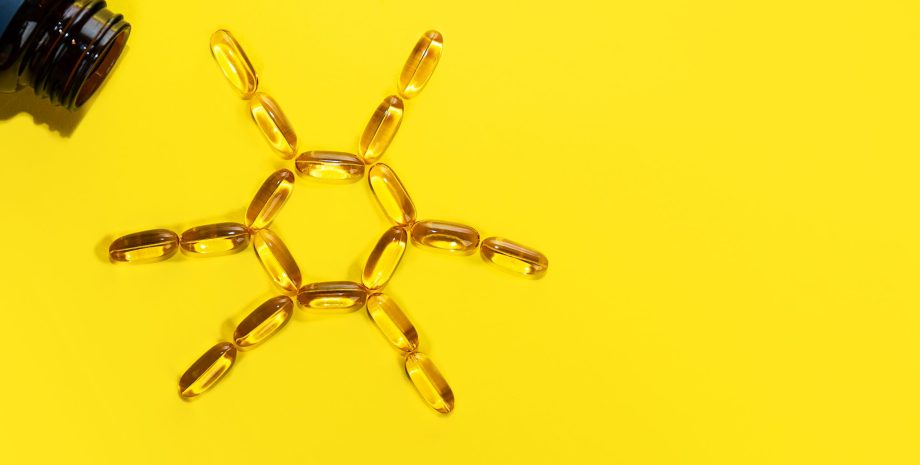

First discovered in 1920, vitamin D has a dual identity. You eat it as a nutrient, and your body produces it as a hormone. It’s essential to building and maintaining bone health and muscle strength, and studies suggest that it can minimize the growth of cancer cells, reduce inflammation, and assist the immune system in controlling infections. The evidence isn’t conclusive, but some research identifies vitamin D as helpful in preventing diabetes, controlling high blood pressure, stemming depression, and even lowering cancer risk.
The vitamin that isn’t
Technically speaking, vitamin D isn’t a vitamin at all because your body produces it, and it’s hard to get from food. In your skin, exposure to UVB light triggers a chemical reaction that breaks down a steroid, 7-dehydrocholesterol, into vitamin D.
So just go outside, soak up the sun, and you’re all good, right? Not so much, Hoosiers. Indiana isn’t a sunshine state, and lots of us spend too little time outdoors to produce enough vitamin D. (Riding in a car doesn’t count, either, unless it’s a convertible, because window glass won’t let UVB rays through.) Skin pigment also reduces vitamin D production because it acts like sunblock. Although food producers fortify some of their products with it, most people get their vitamin D from a supplement, which may contain either vitamin D2 or vitamin D3.
Types of supplements
Vitamin D supplements fall into two categories: vitamin D2, known as ergocalciferol, which comes from plant sources, and vitamin D3, or cholecalciferol, which is derived from animal sources. Some studies suggest that vitamin D3 does a better job of raising and maintaining concentrations in the blood, and some experts recommend it because it’s the form our bodies produce.
Food and vitamin D
If you’d rather get your vitamin D from food, look to fatty fish, including mackerel, salmon, swordfish, tuna, and sardines, along with cod liver oil and fortified foods such as orange juice, dairy, plant- and nut-based milks, and cereals. You’ll also find vitamin D in small amounts in egg yolks, cheese, and beef liver. If you’re vegan, you can obtain some vitamin D from mushrooms, especially if they’re exposed to UVB light as they grow.
The problem with eating your way to healthful vitamin D levels is the sheer amount of food you’ll have to consume to get there. Just to ingest 400 IU of vitamin D, you’d need 32 ounces of fortified orange juice, 16 ounces of tuna, 3 ounces of salmon, 30 ounces of yogurt, 7 ounces of halibut – or 20 egg yolks, which would lead to cholesterol overload.
What’s enough?
How much vitamin D do you need? The daily Recommended Dietary Allowance (RDA) equals 10 micrograms (400 IU) from birth to age 1, 15 micrograms (600 IU) from the age of 19 to the age of 70, and 20 micrograms (800 IU) above that age. And just as getting too little vitamin D isn’t good for you, too much can be harmful. Above 4,000 IU per day, you actually can hurt yourself.
Deficiencies
Some people are at a natural risk for vitamin D deficiency. If you’re lactose intolerant or vegan, you can’t eat the foods that naturally supply vitamin D. If you have celiac disease, ulcerative colitis, Crohn’s disease, or another form of inflammatory bowel disorder, or you’ve had gastric bypass surgery, your condition disrupts your body’s ability to digest vitamin D. Obesity also makes it difficult for the body to use the vitamin D stored in fatty tissue.
Over time, too little vitamin D can cause serious bone disorders. In infants and children, vitamin D deficiency produces rickets, a condition that deforms the bones because they cannot harden properly. In adults, osteomalacia weakens and softens bony tissue, but this condition is curable with vitamin D supplements. Osteoporosis, which makes bones brittle, is incurable.
Overdoing it
Too much vitamin D can cause weight and appetite loss, mental confusion, irregular heartbeat, muscle weakness, dehydration, excessive urination and thirst, vomiting, kidney stones, and a hardening of blood vessels that can lead to heart and kidney damage.
And vitamin D also interacts with some prescription drugs and over-the-counter supplements. Some of these substances raise or lower the levels of vitamin D in your blood beyond healthful levels. High doses of vitamin D can interfere with the functionality of some drugs, including the medications prescribed to lower cholesterol.
The D-finitive word
The bottom line: To stay healthy you need vitamin D—and you’ll probably find it easier to take a supplement than to max out on the dietary sources of this vital nutrient or try for the right amount of sun exposure. And if you’re still not sure how much supplemental vitamin D is the right amount for you, you might want to consult your doctor—that right amount varies by the individual.
Still, it’s summer in Indiana and there’s more opportunity than usual to soak up the sunshine—and vitamin D. So, after you pop your supplement in your mouth, head for the lake or pool and get a little more. But just a little because, yes, sunscreen is still encouraged.